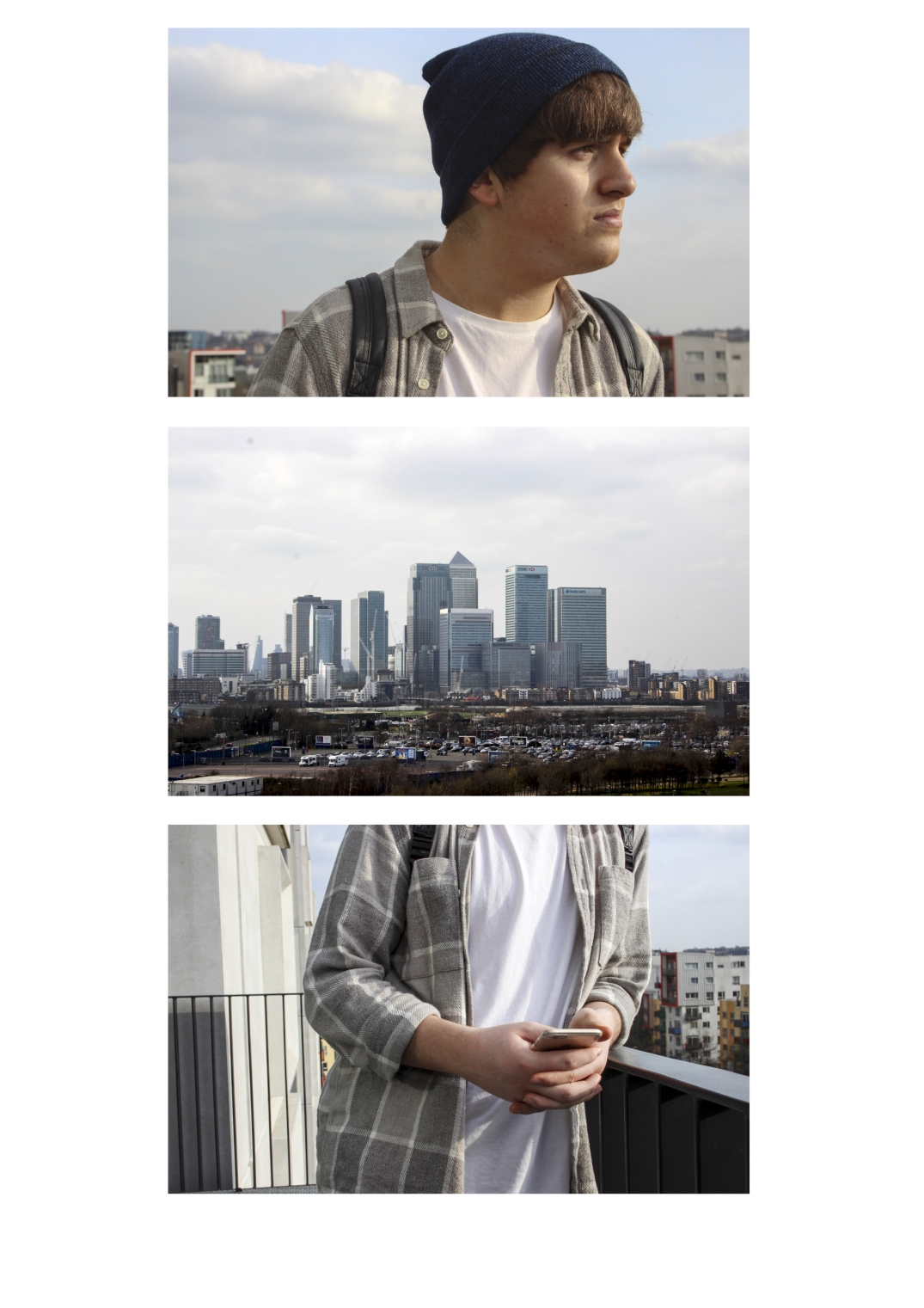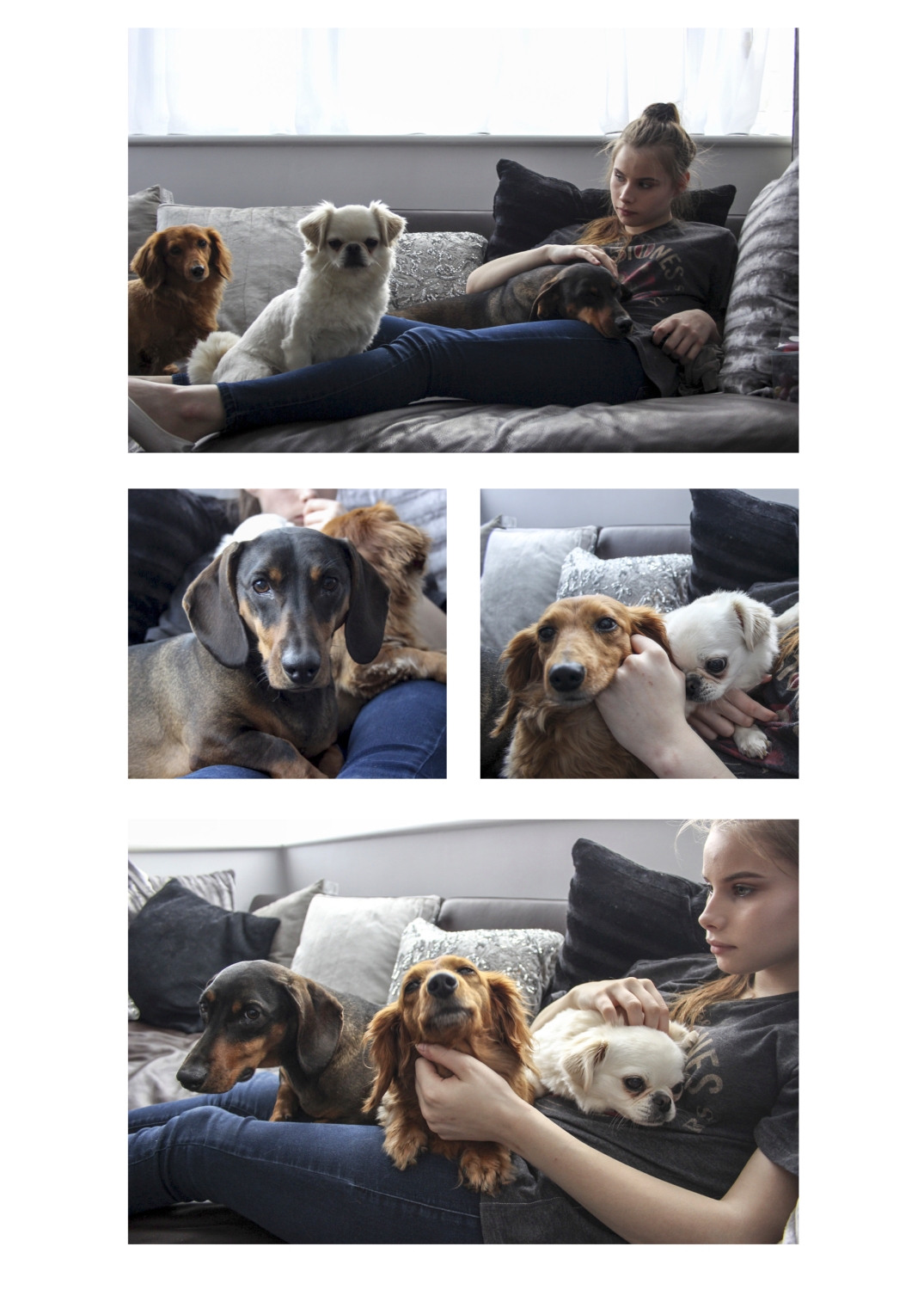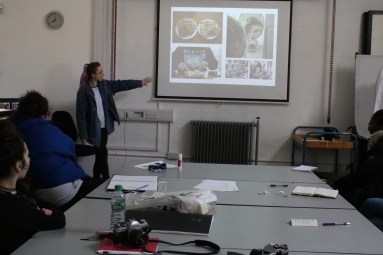I wanted to put these images together as they’re all based on the same theme, of cooking. I like all the different view points and angles that i have captured within this collage. I feel all the images work as you can’t see the models face in any of the images which leaves some mystery of who this person really is, having to look at more images to find out.
I want to place with a lot of different layouts to find out which ones I like best, especially as the number of images in each collage will change. I want to make sure to have a good balance of cropped framed images and wide angles, just to make the overall image look interesting to the viewer as they layout can help make the images look even better. These images were based on being out and running errands, which isn’t very exciting. To make it more exciting I made sure to place different images with hints of colour that complemented one another.
I feel as if this layout is perfect for displaying images that contain details about the model but having one image that is maybe more important than the rest, like a portrait with the models face in the frame. Having the smaller details around will allow the portrait to stand out the most while giving the viewer more of an inside of who this person is and what they do with their private time.
When the selection of images are mostly wide angle I found it’s harder to get ascetically pleasing collage, but it can still be done. I found the tiles needed to be a bit bigger then they would be if the image was more cropped. Making the right template to suit the images is key, for example i prefer the collage to the left over the right as I feel we can see more of the images and get more of a relationship from the two models.

This is one of my favourite collages that I’ve created so far, as all the images tie nicely together because of the colour scheme. Having the two smaller images in the centre of the images is a nice touch of details that might have been looked over. I really like how the top image has the model more to her right of the image with her face showing, then the bottom image the model is more to the left and he face hidden. I feel this balances the image well, with a reflective aspect.
Having the images is a good way to have landscape images. As this was a basic layout I wanted to experiment with the spacing/ having no spacing. Depending on what images are used I feel the images can flow very well, creating a story leading into each other. With this vertical collage I wanted to include both of my models. The collage to the left having two different images of them with a detail of the store we were in to show the viewer how they were interested in music. The collage to the right includes one image of each of the models interested in the music at the top and bottom, while having an image of just their feet to show them together without revealing their faves.

I places these images together as they all are based on the model working at their desk. I made it interesting by creating different view points and angles, even though they are very similar as whats included in the frame they complement each other when placed in this grid as you get a view, almost like the viewer is there.

Within this grid I wanted to include some of the detail within the models life that is used or seen on a regular basis. I wanted the keys to show the one main thing he will always take them leaving the apartment, so maybe that is something overlook for it’s importance. Having the image of the beanies on the opposite corner allowed some balance as it’s quite similar to the picture of the keys, and is something the models uses a lot. I then had one image to show the views they see on their daily walk when leaving the apartment, as well as a cropped image to show relevance to the beanies while outside.
These two grids show two different takes to the models daily walk to uni and how they like to get a drink before getting the day really started. They both show the location in different ways as one included the London skyline and the other a street sign. The grids are very similar except one has space to show two portrait images and the other two landscape images. The left set allows one main image with two smaller ones to help tell the story, while the right showcased all the images more equal as they’re roughly the same size.
These three grids show more detail within the models life, as it gives the viewer more of an in site to what they’re interested in/ use on a daily. I feel using these images take it to a some what personal level as you can only see these personal belongings in their room. I tried to make every image in the grids relate to each other, like the middle grid includes items in the bathroom. Having a shot of the model larger just reminds the viewer who the person is and the smaller details show how treat themselves. The other two are quite similar, I was experimenting with different layouts and seeing what images worked well together. I feel the grid to the right is slightly better as it shows more of the objects that are used quite casually, for example reading or lighting a candle.
I feel these grids have more of an editorial vibe as they’re taken with different angles and different ways of cropping. I really like how there’s mainly white with small part of black and yellow, I feel it keeps the images very clean and brought together. They don’t tell us too much about the model as a person but all of these images together make a strong grid.

This grid shows us where the model is living, giving us more detail about them. I just liked how these images sat together as they have the same colour scheme as well as all linking. As the model is looking at the distance, having the view shown and then having the bottom image placed like that makes it more unique and interesting.
These grids show the model in the park. I wanted to include the caring image of the model with the dog as well as the cropped image of her feet, to include wide angles and cropped. The other spaces I wanted to bring in the models connection with her phone as well as her sense of adventure, roaming around in nature. Both of the top images are quite open which I like as a lot of the bottom images are cropped filling up most of the frame. They just allow more scenery into the grids, opening them up more.
For this grid I experimented with two themes, one focusing on the model doing her colouring to relax and the other being a more overall look at what she does within her room. I really like the colouring of one as it has many different angles, showing the concentration on her face as well as the detailed hand movements. The more over view look of the models day allows us to see more of her life with less of the attention to detail.

What I like about this simple one is how the intimate interactions between the two models, showing the viewers their connection. That is shown more within the phone sharing image, I wanted to place the smiling image next to it as I wanted to show their facial expressions. The smile show a relaxed feel to the grid, inviting us into their friendship in a way.

Within this grid I wanted to include the interactions between the models as well capturing them carefully looking for their favourite records. Doing this allowed a balance within the images having each diagonal image either be them alone or together.

I liked having three different aspects within this grid as it has an image of just the surroundings, a unique image of 3/4 of the models where you can’t see their faces and an image of one of their faces in the location. The colourings really flow well together, allowing the images to all look in the right place.

I wanted to have a grid of my model in her car as it’s not something the rest of my subjects have access to. I like how calm and carefree she looks driving considering how young she is. Capturing different view points within the car it’s almost like the viewer was in the car with the model too, inviting the audience in.

A lot of the models room was white/ grey so to add some colour to the grids I included other details within it, these details also gave the audience more of a story of who this girl really is.

I really like this grid as even though the model looks quite cold she sees her pets everyday and you can tell this by the way the dogs are in the images. They all are quite relaxed, even posing for the picture in some cases. This is good as it’s like taking a portrait of the dogs as well, showing what they’re like too.
























































































































